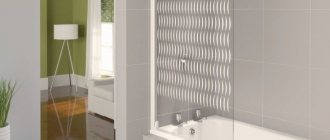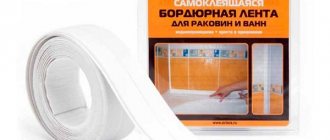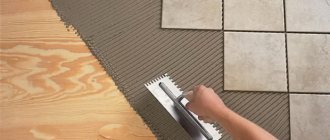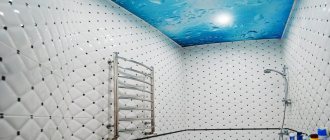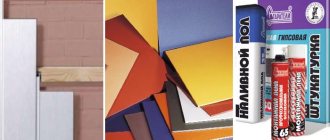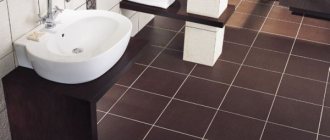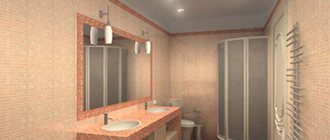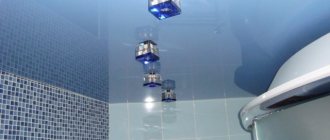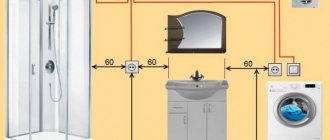Although glass partitions for the bathroom are still considered a novelty, their popularity is increasing every day. Looking from the outside, it can be noted that the design itself is quite simple, however, it is with its help that you can give the bathroom a completely different look. In this case, we are talking not only about design, but also about functionality. First of all, a glass partition for the bathroom will allow you to create two or more functional zones inside one room. In this case, it is recommended to opt for frosted glass partitions, because they will allow you to maintain illumination, but at the same time, provide so-called secrecy. As for aesthetics, a glass bathroom partition will make the room more attractive.
How to install
The bath partition is installed taking into account the layout and wishes of the owner of the apartment or house. There are several options for its placement.
How to make a functional partition in the bathroom:
- use it to separate the shower area (relevant in bathrooms without a shower tray with a built-in drain in the floor);
- fence off the bidet;
- close the bathtub from the area where they change clothes and wash;
- distinguish between a place for hygiene procedures and an area with household appliances;
- separate the bathroom from the bathroom in combined bathrooms.
When designing partition elements in the bathroom, it is necessary to take into account the size of the door, the height of the ceiling, the intended location of furniture and plumbing, and the interior design.
Legal feature
It is no secret that any major changes in the layout of the apartment, such as the demolition of a wall, or its construction must be documented. Of course, if you do not intend to carry out any transactions related to your real estate, there should not be any problems even with illegal changes.
Partial partition in the bathroom
But no one is insured against anything, and fines are a serious matter, so we recommend obtaining permission for planned redevelopment, including them in the appropriate documentation and protecting yourself from possible problems with all sorts of authorities in the future.
Functions of a partition in the bathroom
How the partition will be used in the bathroom and what it will be made of is decided by the owner of the house or apartment. In this case, it is necessary to take into account not only practicality, but also the aesthetics of the room. What functions does the partition element perform:
- Room demarcation. You can divide the bathroom into functional zones using various methods. A fence, for example, will serve as a shower wall or hide a bathtub or toilet. Interesting options include installing decorative columns on both sides of a mirror or sink to separate them from the main room, or arranging a small niche for a washing machine.
- Hiding communications. Installation of a partition structure is necessary for protruding pipes or other technical structures that cannot be hidden under false walls or a screen. Additionally, the structure will serve as a support for lighting or shelves.
- Moisture protection. The partition here is a kind of screen that prevents water splashes from entering the rest of the room.
- Space saving. By making an additional wall in a bathroom with a small area, you can solve the problem of lack of space for placing and storing hygiene items. Shelves, hooks and hangers for clothes and towels are mounted on the partition.
- Comfort of use. The partition between the bath and shower makes it possible for two people to use them comfortably at the same time. Also, for convenience, you can install a false wall, separating the sink from the bathtub or toilet. Partition structures in plastic bathrooms, due to their hygiene, ease of installation and low cost, are used in public places (train stations, cafeterias, etc.), where toilets and sometimes showers are visited by a large number of people.
The decorative function of the partition elements is also important. A high-tech style bathtub with a glass partition on a metal frame looks good. And the currently fashionable Asian style will be emphasized by a bamboo design.
Advantages
Before you finally decide to use partitions in your bathroom , you need to familiarize yourself with their advantages, and there are 4 of them:
- maintaining the integrity of the room - this advantage is perfect for glass products; thanks to their transparency, they will not affect the visual perception of the bathroom;
- high wear resistance - Whatever material this product is made of, it will have good wear. Moreover, such fragile materials as glass, plastic, plasterboard are covered with a special protective layer, which ensures a long service life;
- convenient use - During use there are no difficulties with cleaning and washing the fences;
- blocks of complex, multifunctional design. You can choose sliding partitions that are convenient to use to separate the washing area or toilet.
Materials
There are many options for making a comfortable and beautiful partition in the bathroom. It could be:
- reinforced concrete;
- aerated concrete and foam concrete blocks;
- strained glass;
- brick;
- decorative rock;
- glass blocks;
- plasterboard for wet rooms;
- PVC panels.
Brick, stone, building blocks and reinforced concrete are used to construct solid bulkheads.
Due to their low strength, other materials are used when installing false walls that serve for decorating and zoning space.
Glass blocks are perfect for dividing a bathroom into zones, and sliding walls made of glass and polycarbonate are ideal for zoning a bathtub.
To construct a partition element separating the toilet and bathtub, it is better to use brick, plasterboard or concrete.
Many building materials for making partitions have a porous structure; moisture easily penetrates through it.
When constructing false walls from such materials in rooms with high humidity, it is necessary to use waterproofing to prevent water seepage.
These can be plaster compositions, lubricating and penetrating substances based on bitumen or polymer. They are easy to apply, dry quickly, and do not interfere with further finishing. Bathroom partitions are decorated with mosaics, PVC panels, tiles, and sometimes with moisture-resistant wallpaper.
Massive partitions
It is justified to create a structure made of brick, concrete or building blocks if the partition is planned without moving. They are usually installed between the toilet and the bathroom. Concrete, brick and stone walls have a high degree of wear resistance; their designs have many options: in the shape of pyramids, with niches, recesses.
Let's look at the pros and cons of partition structures of this type:
| Advantages | Imperfections |
| A wall made of heavy building material delimits the space and allows you to hide all communications. | The products are thick and take up a lot of space in the bathroom. |
| By constructing a solid partition, good noise insulation can be achieved. | The structures cannot be moved and are not sliding. |
| A block or brick can be covered with tiles that are not affected by moisture and temperature changes. | If the new wall in the bathroom is solid or solid, then it must be included in the floor plan. |
| A sink or heavy shelves can easily be attached to the partition. | Brick walls cannot be given any shape, since the material is practically not processed. |
As a rule, a concrete base is made first, and the partition element is laid out in brick, or it acts as a foundation for the more popular glass partition. If you have the finances, instead of brick, you can take natural stone or line the wall with its artificial counterpart.
Glass
This material for false walls in the bathroom is in demand due to its excellent decorative appearance and ability to visually expand the small space of the room.
Glass partition structures come in various types - hanging, sliding, transformable.
Such fences are made from glass blocks or tempered glass. The latter option is more durable and can serve without loss of quality for several decades. But glass blocks are also treated with specialized compounds to protect them from mechanical damage and scratches and repel dust.
The surface of the partition can be decorated with designs using either special glass paints or by applying patterns from vinyl film. There are also ready-made options with patterned decor.
A glass partition in the bathroom has certain pros and cons:
| Advantages | Imperfections |
| Structural elements can be added to zone different parts of the bathroom, since glass is not affected by water. | Glass requires constant care, because even small splashes can leave large streaks and stains on it. |
| It is not difficult to care for glass structures - dirt can be quickly cleaned with a regular damp cloth. | Partition glass elements provide almost no protection from extraneous sounds. |
| You can choose a glass design for bathrooms with different interiors and sizes, even for the smallest rooms. | It will not be possible to hide wires, pipes, or other communications behind a transparent wall. |
| Thanks to the light transmission properties and transparency of the glass partition element, the bathroom looks lighter, brighter and more spacious. | Owners of houses and apartments with above-average income can afford such designs. |
Installation of a glass partition is carried out using a special profile or metal brackets. If the structure is sliding, the roller mechanism is mounted along the wall or in an in-wall “pencil case”. Volumetric fencing is created from individual glass sheets connected by plastic profiles.
To create a glass block partition structure, you can use two methods. The first of these is to use a special glass glue. In this case, glass blocks are laid almost in the same way as foam concrete ones, but not in a checkerboard pattern, but one on top of the other.
Align the elements with each other using plastic tile dividers.
To ensure that the row is level relative to the walls and ceiling, driven nails are used. You can place no more than five rows daily. The joints are grouted one day after installation to allow the adhesive to completely dry.
You can create a partition from glass blocks using the pure method. No glue is needed here; the elements are connected to each other by special modules made of plastic or aluminum.
They have grooves for interlocking with each other and holding the glass blocks. The assembled structure is attached to the walls and floor with screws. This method allows you to make a partition element in the bathroom of different configurations - in the form of a ladder, a pyramid, with openings.
Plastic
A plastic partition for a bathroom can be framed from PVC panels or block made from plexiglass. In the first case, the fastening is carried out on a metal frame like plasterboard. Plastic partitions made from blocks in the bathroom are installed and secured in the same way as their glass counterparts.
Plastic will give the structure a modern look. It is inexpensive, hygienic, not afraid of moisture, and there are many design options. But PVC has significant disadvantages. The material deteriorates quite quickly, turns yellow, is susceptible to damage from weak mechanical influences, and dents and scratches are visible on it. Because of this, the PVC partition element will not last long.
Drywall
Plasterboard walls in the bathroom are structures based on a metal frame, sheathed on both sides with plasterboard sheets. The void between the sheets can be filled with soundproofing material.
Installation of a plasterboard partition is quite easy. Even an inexperienced person can easily make a plasterboard false wall. Even without the involvement of specialists, the entire process takes a little time. And buying the material won’t hurt your wallet.
What are the advantages and disadvantages of drywall:
| pros | Minuses |
| The material is smooth and easy to decorate. The board is easy to process, so gypsum plasterboard can easily be used to create partitions of various configurations. | A plasterboard wall needs finishing - putty, plaster, facing with ceramic tiles and other decorative materials. |
| Good breathability. | Use in rooms with humidity above ninety percent is not recommended. |
| Light weight. | It is impossible to assemble sliding partitions. |
| If necessary, the plasterboard wall can be easily dismantled. | Before covering such fences, be sure to fill them with sound-insulating material - mineral wool, ecowool or mineral slabs. |
Plasterboard sheets and panels are perfect for hiding wires, pipes, and other communication options.
Self-installation
Do-it-yourself bathroom renovation and design is most often done using structures made of moisture-resistant plasterboard. This is due to the low cost of the material and ease of installation. When assembling a gypsum board wall in the bathroom, you need to think in advance about the arrangement of additional lighting and the location of the built-in shelves. If a partition in the bathroom is needed only for differentiation, communications can be removed inside it, and the rest of the space can be filled with soundproofing material. Mineral wool slabs that do not deform due to their structure are suitable for this purpose.
When calculating the required number of sheets of drywall in a bathroom for a partition, you need to multiply the resulting number by two, because the structure is sheathed on both sides.
Rack profiles are mounted vertically with a distance of 0.6 m between them, and guides are mounted horizontally, on the floor and ceiling.
The stability of the wall depends on the fasteners. The profile is secured to the surface with screws and dowels, and the rack elements are attached to the guides with screws for metal. When sheathing the frame with plasterboard sheets, self-tapping screws with a countersunk head are used.
For external pre-finishing of a plasterboard wall, you will need a primer, moisture-resistant putty, and fiberglass tape to reinforce the seams.
Tools required for installation of a plasterboard partition element:
- hammer drill, concrete drills;
- screwdriver;
- metal scissors;
- gypsum board cutter;
- level;
- two or three spatulas, a brush;
- container for primer and putty.
Having collected everything you need, you can begin assembling the plasterboard wall for the bath with your own hands.
Flaws
Despite the fact that glass structures have many positive qualities, they also have certain disadvantages. Not all of them are significant, but some may influence the choice of future material for decorating the bathroom:
- The most significant drawback is the high cost. Glass itself is not expensive, however, thick tempered panels are used for walls, the price of which is already much higher.
- If desired, such a partition can still be broken. In this case, there is a risk of injury or more significant injury.
- On such surfaces there are always traces of interaction with them - handprints, water drips or traces of dried drops. You will have to constantly ensure that the surfaces remain clean and wipe them.
The rest is not so important and significant. The main one of all the overpowering shortcomings will be the price, and it is this point that usually tips the scales in favor of other finishing materials.
